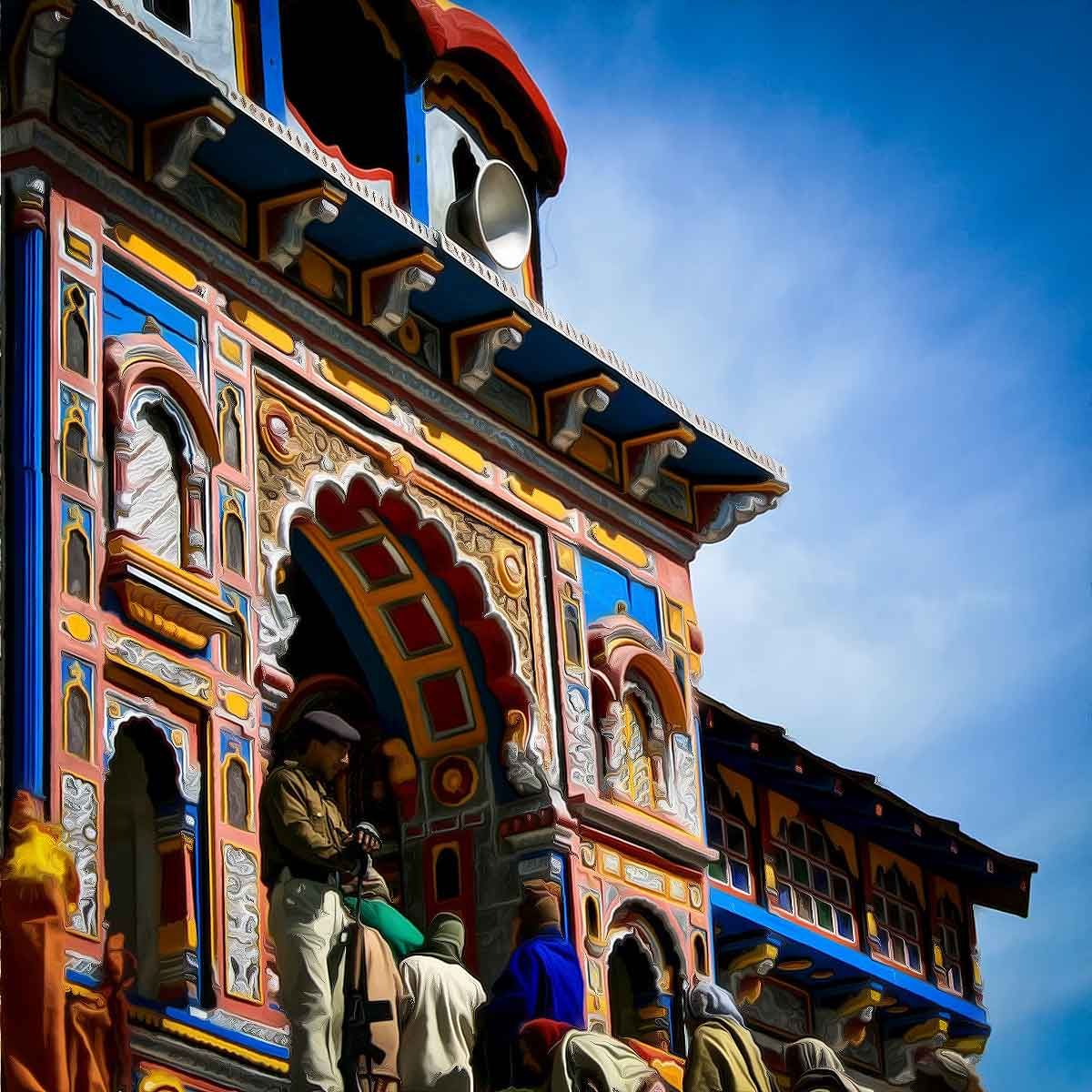More Coverage
Twitter Coverage
Satyaagrah
Written on
Satyaagrah
Written on
Satyaagrah
Written on
Satyaagrah
Written on
Satyaagrah
Written on
Join Satyaagrah Social Media
"PM Modi's dream project" - Govt investing 481 crores to transform Badrinath, a major Hindu pilgrimage into a Spiritual smart hill by 2025 under Badrinath Master Plan 2023, initiative will enhance local economy, tourism, accessibility, and infrastructure

Badrinath, a city in India's Uttarakhand region, is a major holy destination for Hindus around the world. It's quite common for folks from distant places to journey here at least once in their lives. With each passing year, more and more pilgrims are making their way to Badrinath. Now, the government has a big plan to make Badrinath even better for everyone. They're calling it the Badrinath Master Plan 2023.
According to the latest news, the government is putting in a lot of effort, about 481 crore rupees (an Indian currency), to be exact, to improve Badrinath. The aim is to turn it into a mini smart city by 2025. This is a similar effort to what they are doing with another sacred place, Kedarnath.
As part of this plan, the government is working hard to improve the facilities for tourists. The Tourism Secretary, Dilip Javalkar, even went to Badrinath to check how things are progressing. He says the plan is to make Badrinath look even more heavenly and impressive. Prime Minister Narendra Modi is keen on this plan, as he wants to develop Badrinath like they are doing with Kedarnath.
As part of the improvements, they plan to make it easier to get to the Badrinath temple and to enhance local economy. This means that it will be easier for pilgrims to go from the temple to other holy places, like Tapt Kund.
The government had experts conduct surveys to make sure the construction works are safe and convenient. The experts gave advice on many places in and around Badrinath, including Tapt Kund, Brahma Kapal, Narada Kund, Sugriva Shila, Alaknanda river banks, Saket Tiraha, Mana Chawraha, and more.
The Master Plan has various stages and features. In the first stage, they'll work on improving things like the lakefront, the riverfront, the arrival plaza, the city center, the road loop, the hospital, and the BRO road. In the second stage, they will improve the areas around the Badrinath temple. And in the third stage, they'll work on creating a faith path from the lake to the temple.
When the four mountain shrines, known as the four dhams, are open, there is a peak in pilgrimage activity for about 45 days. This is often because schools and colleges have their summer break, and because the plains are very hot. But recently, there's been more activity from September to November.
However, the Prime Minister’s dream project, the Badrinath Mahayojana, is big news. People are worried that the comfort of the pilgrims and the concerns of the traders are not being considered. But once the plan is completed, Badrinath will surely be more rejuvenated.
Right now, the Joint Justice, who is overseeing the Badrinath Plan, has taken 12 rooms from the Dalmia and Modi Dharamshalas (rest houses) of the Badri-Kedar Temple Committee. These rooms will be given to the Panda Purohits (Hindu priests), whose ancestral homes will be demolished as part of the plan. Up till now, several shops and houses around the temple in Badrinath have already been taken down.
|
Badrinath Masterplan: A Sustainable Reimagining of a Spiritual Haven
Nestled within the Himalayan mountains, the town of Badrinath in Uttarakhand, India is a sacred pilgrimage destination for Hindus worldwide. Known for the ancient Badrinarayan Temple, dedicated to Lord Vishnu, and the matha (monastery) established by Adi Guru Shankaracharya, this spiritual hub forms part of the Char Dham Yatra and the Chota Char Dham.
Badrinath is home to a fluctuating populace living in ashrams, dharamshalas (pilgrim rest houses), and hotels along its serpentine streets. It witnesses a considerable influx of devotees during the yatra (pilgrimage) season from April to November every year. However, the town's charm and significance face challenges owing to unchecked growth and inadequate infrastructure.
Services and Site Area: The Blueprint for Revival | Covering an area of 85.06 hectares, the Badrinath Redevelopment project, backed by the Uttarakhand State Government, sought to counter these issues. Services offered in this project include feasibility study, master planning, urban design, building design, architecture, MEPF engineering, detailed project report (DPR), transportation, infrastructure planning, engineering, project management consulting (PMC), landscape design, sustainability, and green certification.
Under the project, a comprehensive Master Plan for the town's redevelopment was prepared by INI, a renowned firm. The Master Plan involves a detailed assessment of existing conditions, identifying problems, and proposing robust physical and social infrastructure solutions for phased implementation.
Temple Precincts Reorganized, Orientation Redefined | The Badrinarayan Temple, a key focal point, had lost some of its prominence due to haphazard construction and clutter in its vicinity. The Master Plan's first objective was to identify and remove unnecessary structures to decongest and redefine the temple precincts. The idea was to create a sense of place, extend space for pilgrims, and ensure accessibility for differently-abled individuals.
Structures were meticulously arranged on either side of the temple, seated on an elevated platform and surrounded by a landscaped expanse. This allowed for an unhindered visual link from the temple across the Alakananda River, connecting the whole town on the other side.
|
Master Plan: Infrastructure Unification
The visual connect, achieved through bridges over the river, extends to the internal streets and an open plaza, leading to the Shesh-Netra Lake. This lake-park, flanked by lush landscaping, further connects to another major lake-park up north, providing a sense of arrival to visitors.
The street network leading from the public plazas around the two lakes throughout the town has been upgraded for resilience and navigability. All public infrastructure, including water supply, sanitation, and waste disposal, have been overhauled.
Significant attention has been paid to redefine and beautify the river front and ghats (river steps). Robust transport links have been established between key spots within and outside Badrinath, such as Tapt Kund, Brahma Kapal, Leeladungi, mata murti and Ganesh temples, Vyas Gufa, Bhim Pul, and Mana, India’s last village before the Indo-Tibetan border.
 |
Learning from Global Models
For benchmarking the Badrinath Masterplan, national and international hill area developments were studied. The idea was to create a model for developing hill towns in India. The plan includes bylaws to guide future town development, thereby mitigating potential damage from natural disasters that the fragile ecosystem is susceptible to.
One of the key strategies of the plan is promoting responsible tourism while discouraging reckless construction and controlling town growth. The design aims to protect the Alakananda River edge and ecosystem from flooding and erosion damage. This holistic plan acknowledges the town's religious, socio-cultural, economic, and environmental features and accounts for all these aspects in the proposed development.
Balancing Culture and Ecology
In summary, the Badrinath Masterplan 2023 aims to ensure cultural perpetuity within fragile ecosystems through integrated sustainable development strategies. It strives to redefine the sacred town of Badrinath while ensuring that it remains a spiritually fulfilling and environmentally sustainable destination for all its visitors.
The Masterplan aims to invigorate the town, making it a modern yet traditional, vibrant yet tranquil, and functional yet sacred space for the countless pilgrims and tourists who flock here every year. It is not just a vision for a town's transformation, but a blueprint for harmonizing human endeavor with nature's bounty, faith with sustainability, and heritage with progress.
|
Oil PSUs partner in spiritual smart hill town vision
Badrinath Dham, a revered site nestled in the Himalayan state of Uttarakhand, is all set for a significant makeover. A Memorandum of Understanding (MOU) was signed on Thursday by the Oil and Gas Public Sector Undertakings (PSUs) and Shri Badrinath Utthan Charitable Trust, paving the way for the redevelopment of Badrinath Dham as a 'Spiritual Smart Hill Town.'
Key Participants in the Redevelopment Initiative | The Oil and Gas PSUs involved in this transformative endeavor include prestigious names like Indian Oil, Bharat Petroleum Corporation Limited (BPCL), Hindustan Petroleum Corporation Limited (HPCL), Oil and Natural Gas Corporation (ONGC), and GAIL.
Understanding the MOU and the Redevelopment Plans | According to the MOU, these Oil and Gas PSUs will collectively contribute ₹99.60 crore in the first phase of developmental activities. The funds will be directed towards a host of infrastructure improvements designed to enhance the experience of visitors and devotees. These enhancements include work on river embankments, building all-terrain vehicular paths, constructing new bridges and beautifying existing ones.
In addition, the project also focuses on improving living conditions and facilities in the area. This includes setting up gurukul (traditional educational) facilities complete with accommodation, improving sanitation by creating toilet facilities, and providing clean drinking water. The project will also focus on boosting safety and visibility by installing streetlights and will enhance the aesthetic appeal of the town with mural paintings.
Celebrating the Initiative: Statements from the Dignitaries | This auspicious occasion of signing the MOU was graced by several dignitaries including Uttarakhand Chief Minister Tirath Singh Rawat, Minister of Petroleum and Natural Gas and Steel Dharmendra Pradhan, state's Tourism Minister Satpal Maharaj, along with senior officers from the state government and the Oil and Gas PSUs.
Rawat extended his warm congratulations to Pradhan and the Oil and Gas PSUs for their support towards this noble initiative. He recognized the spiritual significance of Badrinath Dham, saying, "Shri Badrinath Dham holds a unique place in the hearts of our countrymen. As one of the most sacred sites in our nation, it is crucial that we equip it with the best facilities for the numerous pilgrims who journey here from all over the country."
He expressed optimism that with the combined efforts of the Uttarakhand government and the Oil and Gas PSUs, the rejuvenation work of Badrinath Dham would be completed within a three-year span.
Pradhan, on his part, acknowledged the deep spiritual, religious, and cultural resonance that the Char Dham, including Badrinath, holds for millions of Indians. He said, "Today's event marks a significant step towards Prime Minister Narendra Modi's vision of transforming the Badrinath shrine into a mini smart and spiritual city, all the while maintaining its religious sanctity and mythological importance."
He further expressed his joy that the Oil and Gas PSUs have stepped forward to help realize this vision. He noted, "Development of sites like Badrinath will attract more tourists, which in turn will bolster the economy of the state. Tourism is a key industry playing a vital role in the state's development, and initiatives like this one further its progress."
The signing of this MOU indeed marks an important milestone in the journey towards transforming Badrinath Dham into a 'Smart Spiritual Town', harmoniously blending spiritual significance with modern amenities.
Uttarakhand's top Tourism official examines ongoing developments
In the scenic state of Uttarakhand, nestled in the heart of India, the grand project of revamping the holy town of Badrinath is underway. The revered Badrinath Dham is one of the most cherished pilgrim towns of Uttarakhand, attracting devout followers from across the country. The man overseeing this ambitious project is Bhaskar Khulbe, the Special Executive Officer in the Uttarakhand Tourism Department.
On Sunday, Khulbe carried out a review of the ongoing construction work under the Badrinath Master Plan. He expressed satisfaction with the swift pace of the project and conveyed his admiration for the local administration's dedication. With a sense of excitement, Khulbe stated, "Once this project is completed, Badrinath Dham will radiate an even more divine and majestic aura. The devotees journeying to this sacred site will have access to enhanced facilities, adding to their spiritual experience."
The Badrinath Master Plan is a comprehensive blueprint to transform the Badrinath Dham into a 'Smart Spiritual Hill Town'. This undertaking has been initiated with a robust investment of Rs 425 crore in its first phase. The master plan aims to resolve several issues, including unchecked and haphazard construction activity and congested streets.
The objective is to make the town more accessible and comfortable for the pilgrims, without compromising its inherent spiritual essence. This initiative echoes the successful redevelopment of Kedarnath under Prime Minister Narendra Modi's guidance, which transformed Kedarpur into a grand, divine site that has since welcomed numerous pilgrims.
According to data from the Uttarakhand Tourism Department, since the commencement of the Chardham Yatra on April 22, more than 8 lakh pilgrims have visited the holy shrines of Kedarnath, Badrinath, Gangotri, and Yamunotri.
The state's Tourism Minister, Satpal Maharaj, announced plans to extend air services in the state to facilitate smoother travel for pilgrims. Concurrently, the state is making strides with the Char Dham All Weather Road and Rishikesh-Karanprayag Rail Project. There are also plans to construct ropeways from Govindghat to Hemkund Sahib and Sonprayag-Kedarnath within the next three years.
Furthermore, the state government has sanctioned a ropeway project from Kharsali to Yamunotri, budgeted at over Rs 166 crore, to enhance connectivity and ease of travel.
It's worth noting that in its efforts to promote religious tourism, the government has developed multiple religious circuits. These include Shakta, Shaiva, Vaishnava, Golju, Gurudwara, Hanuman, Nag Devta, Swami Vivekananda, Mahasu Devta, Narasimha Devta, and Navagraha Devta circuits. These diverse circuits will provide a broader spiritual journey for the pilgrims who embark on the Chardham Yatra.
In essence, the ongoing development work under the Badrinath Master Plan promises a more enriched and comfortable pilgrimage experience. With better infrastructure and enhanced connectivity, it aims to preserve the sacred ambiance of the town while making it a more welcoming destination for the spiritual journey of the devout.
 Support Us
Support Us
Satyagraha was born from the heart of our land, with an undying aim to unveil the true essence of Bharat. It seeks to illuminate the hidden tales of our valiant freedom fighters and the rich chronicles that haven't yet sung their complete melody in the mainstream.
While platforms like NDTV and 'The Wire' effortlessly garner funds under the banner of safeguarding democracy, we at Satyagraha walk a different path. Our strength and resonance come from you. In this journey to weave a stronger Bharat, every little contribution amplifies our voice. Let's come together, contribute as you can, and champion the true spirit of our nation.
 |  |  |
| ICICI Bank of Satyaagrah | Razorpay Bank of Satyaagrah | PayPal Bank of Satyaagrah - For International Payments |
If all above doesn't work, then try the LINK below:
Please share the article on other platforms
DISCLAIMER: The author is solely responsible for the views expressed in this article. The author carries the responsibility for citing and/or licensing of images utilized within the text. The website also frequently uses non-commercial images for representational purposes only in line with the article. We are not responsible for the authenticity of such images. If some images have a copyright issue, we request the person/entity to contact us at This email address is being protected from spambots. You need JavaScript enabled to view it. and we will take the necessary actions to resolve the issue.
Related Articles
- "Igniting India's resurgence: An epochal infrastructural odyssey": PM Modi inaugurates India's longest cable-stayed Sudarshan Setu, ignites a ₹4,150 crore development wave in Dwarka, embarks on a spiritual dive in Dwarka, blending heritage with progress
- "A leap in Ladakh, a legacy for the world": India propels into a green future, launching its pioneering hydrogen bus trials in Ladakh, a bold leap in green energy, setting a global benchmark in combating climate change through innovative initiatives
- “The Sea, once it casts its spell, holds one in its net of wonder forever”: A new era in cruise tourism and maritime trade across the nation started with the launch of India’s first international tourist cruise ship from Chennai to Sri Lanka
- BJP’s aim to restore the Sanatan faith, glorious history and pride of India: ‘How can Mathura-Vrindavan be left behind,’ says Yogi Adityanath ahead of visiting Krishna Janmabhoomi
- "As dreams meet destiny, the world watches with bated breath": Srinagar beams under the global spotlight as the enchanting Kashmir readies for Miss World 2023, 'Mind-blowing' echoes Karolina Bielawska, encapsulating the valley's mesmerizing allure
- In yet another milestone of BJP, Indian Railways First-Ever Freight Train Reaches ‘Rani Gaidinliu Railway Station’ marking a major breakthrough for railway authorities: Manipur
- PM Modi inaugurates rebuilt Shankaracharya samadhi in Kedarnath and said ‘Adi Shankara brought life to a sleeping civilisation, awakened Bharat to rise above caste boundaries’
- "Experience the majestic 'Yashobhoomi', an emblem of India's advancements in global conventions and expos, developed with a budget of Rs. 5400 crore, it encompasses 73,000 sqm, featuring 15 convention rooms with the capacity to host 11,000 delegates
- "300 meetings, 200 hours, 15 drafts and the indomitable spirit of 4 diplomats": Discover the untold behind-the-scenes efforts at the monumental G20 Summit in forging a consensus on the Ukraine issue, marking a significant milestone in global diplomacy
- “The bigmouths never visited Lord Ram’s birthplace and kept on playing politics”: Ram Mandir chief priest says only BJP cares about Ram Mandir, Modi did Shilanyas and CM Yogi visited 40 times
- Semiconductor Titans, Micron, Applied Materials, and Lam forging robust alliances with India, unveiling monumental billion-dollar investments to significantly bolster India's Semiconductor Mission and usher a future of unprecedented tech advancements
- Bangladesh and India put the final nail in the coffin of China’s ‘String of Pearls’ with access to Chittagong port as it was offered by PM Sheikh Hasina for use by India for trade and uninterrupted commerce
- “Sacred space is where you can find yourself over and over again”: Goa govt inked a MOU with Temple Connect to position Goa, popularly known as 'Bhagwan Parshuram Bhoomi', to be a global destination for spiritual tourism as 'Dakshin Kashi' of India
- 'Older than history, older than tradition, even older than legend...': The millennia-old history of Kashi
- "Education is the development of power and ideal": India witnessed significant increase of 87% in MBBS seats, 105% in PG seats in last 8 years, 96% in GMC, 22 new AIIMS and projects for the upgradation of 75 Government medical colleges under PMSSY
























